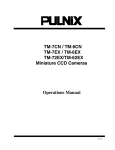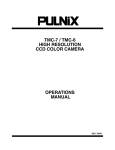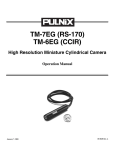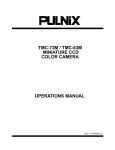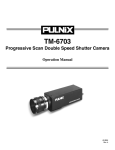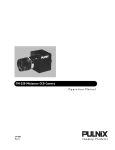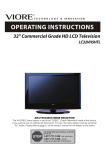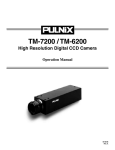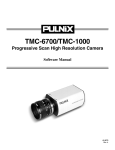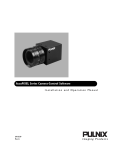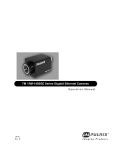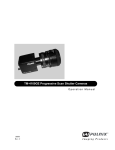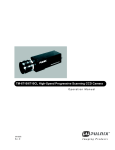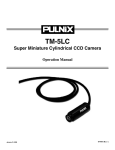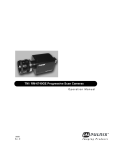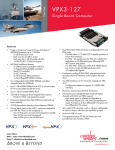Download Pulnix TM-200 Instruction manual
Transcript
TM-200/TM-300 Miniature CCD Camera Operation Manual 69-0047 Re v. B Notice The material contained in this manual consists of information that is proprietary to JAI PULNiX, Inc., and may only be used by the purchasers of the product. JAI PULNiX , Inc. makes no warranty for the use of its product and assumes no responsibility for any errors which may appear or for damages resulting from the use of the information contained herein. JAI PULNiX , Inc. reserves the right to make changes without notice. Warranty All of our solid state cameras have a full three year warranty. If any such product proves defective during this warranty period, JAI PULNiX , Inc. will repair the defective product without charge for parts and labor or will provide a replacement in exchange for the defective product. This warranty shall not apply to any damage, defect or failure caused by improper use or inadequate maintenance and use. Certifications UL CE FCC This equipment has been tested and found to comply with the limits for a Class A digital device, pursuant to Part 15 of the FCC Rules. These limits are designed to provide reasonable protection against harmful interference when the equipment is operated in a commercial environment. This equipment generates, uses and can radiate radio frequency energy and, if not installed and used in accordance with the instruction manual, may cause harmful interference to radio communications. Operation of this equipment in a residential area is likely to cause harmful interference in which case the user will be required to correct the interference at his own expense. WARNING Changes or modifications to this unit not expressly approved by the party responsible for FCC compliance could void the user’s authority to operate the equipment. TM-200 Operation Manual JAI PULNiX, Inc. 625 River Oaks Parkway San Jose, CA 95134 Tel: (408) 383-0300 Tel: (800) 445-5444 Fax: (408) 383-0301 Table of Contents 1 INTRODUCTION 1.1 1.2 1.3 1.4 1.5 Product Description .......................................................................... 1 Features ........................................................................................... 1 Functional Options ........................................................................... 2 Applications ...................................................................................... 3 System Configuration ....................................................................... 3 2 INSTALLATION 2.1 2.2 3.2 ..................................................................... 4 Getting Started ................................................................................. 4 2.1.1 Unpacking Instructions ........................................................ 4 2.1.2 Components List ................................................................. 4 2.1.3 Accessories ......................................................................... 4 Camera Setup .................................................................................. 5 2.2.1 Connector Pin Configurations ............................................. 5 2.2.2 Power Supply and Power Cable Setup ................................ 5 2.2.3 Attaching the Video Output ................................................. 7 2.2.4 Attaching the Camera Lens ................................................. 7 2.2.5 Back Focusing the Lens ...................................................... 7 2.2.6 Auto-Iris Lens Setup ............................................................ 7 2.2.7 Monitor Display Mode .......................................................... 7 2.2.8 Connectors and Cables ....................................................... 8 3 OPERATION 3.1 .................................................................... 1 .......................................................................... 9 Modes of Operation .......................................................................... 9 3.1.1 External Switches ................................................................ 9 3.1.2 Shutter Control .................................................................... 9 3.1.3 Field and Frame Modes ...................................................... 9 3.1.4 Integration ........................................................................... 10 3.1.5 External Sync ...................................................................... 10 3.1.6 Timing ................................................................................. 11 3.1.7 Interfacing to Frame Grabbers ............................................ 12 3.1.8 Sync Output and Clock Output ............................................ 12 Board Layout and Adjustment .......................................................... 12 3.2.1 Processor Board ................................................................. 12 3.2.2 Mother Board ...................................................................... 12 4 TROUBLESHOOTING 4.1 4.2 Problems and Solutions ................................................................... 14 4.1.1 Symptom: No Video ............................................................. 14 4.1.2 Symptom: Dark Video .......................................................... 14 4.1.3 Symptom: Non-synchronized Video .................................... 14 Information and Support Resources ................................................ 15 5 APPENDIX 5.1 ........................................................... 14 ............................................................................. 16 Specifications ................................................................................... 16 i Table of Contents 5.2 5.1.1 Product Specifications ......................................................... 16 5.1.2 Physical Dimensions ............................................................ 17 5.1.3 Glass Specifications ............................................................ 17 5.1.4 C-Mount Specifications ........................................................ 17 5.1.5 Front End Detail ................................................................... 19 Spectral Response ........................................................................... 20 ii List of Figures FIGURE 1. TM-200 System Configuration ................................................... 3 FIGURE 2. 12P-02 Interface Cable (optional) FIGURE 3. TM-200 Rear Panel FIGURE 4. Shutter Control Settings FIGURE 5. Input Signals FIGURE 6. TM-200/TM-300 Timing Chart FIGURE 7. Processor Board FIGURE 8. Physical Dimensions FIGURE 9. Camera Front End - Glass Specifications FIGURE 10. C-Mount FIGURE 11. Combination With “CS-Mount” Camera FIGURE 12. Front End Detail FIGURE 13. Front End Assembly ...................................................................19 FIGURE 14. Spectral Response .....................................................................20 .............................................. 6 ....................................................................9 ............................................................. 9 ..............................................................................11 .................................................... 11 ........................................................................12 ..................................................................17 .................................. 17 .....................................................................................17 iii ...................................... 18 .........................................................................19 June 15, 1998 TM-200 / TM-300 Miniature CCD Camera Operations Manual 1 INTRODUCTION 1.1 Product Description The TM-200/300 is designed to be a simple yet high quality camera capable of meeting a variety of application requirements. Featuring an advanced Had-type interline transfer 1/2" CCD imager, this miniaturized high resolution camera offers many standard and optional features at a very affordable price. It is available in both EIA (TM-200) and CCIR (TM-300) formats. 1.2 Features • Variable electronic shutter and random CCD integration. The substrate drain-type shutter mechanism provides a superb picture at various speeds without smearing. The electronic shutter rate can be externally adjusted, from 1/60 to 1/10,000 in discrete steps, via a manually controlled dial switch. • Miniaturized and lightweight. The use of a CCD image sensor in the video camera module and the development of special mini C-mount lenses makes it possible to produce a very compact, lightweight and robust camera small enough to operate just like a remoted head. • High sensitivity. The TM-200/TM-300 camera is one of the most low light sensitive 1/2" CCD cameras available today. This feature is especially important when using the faster shutter speeds. The CCD detects images into the near infrared. It requires only 1.0 lux of minimum illumination and 0.5 lux minimum illumination at maximum gain. In general, this allows use of a higher lens f-value while providing greater depth of field and sharper images. Page 1 INTRODUCTION • Precise image geometry. On the CCD image sensor, the photosensor elements form exact rows both horizontally and vertically so that a very precise image geometry may be obtained. • Low lag/high resistance to image burning. Since the CCD is highly resistant to image burning, the camera may be exposed to bright objects for a long period of time. Because a “smear” phenomena may occur when shooting a very bright object, an infrared cutoff filter is recommended to obtain a clear picture. • AGC selection, manual gain control and gamma adjustment. These adjustments, which are particularly important in vision system applications, are externally adjustable via switches on the rear plate. • Genlock circuit. A genlock circuit is built in to accept external sync for applications in which external sync is required. • High resistance to magnetic field and vibration/mechanical shock. Due to its ruggedized design, the CCD imager can withstand strong vibration and shock with little or no noise appearing in the picture. Since the TM-200/TM-300 is not influenced by a magnetic field, it will produce stable images even when placed next to objects such as electric furnaces, welding machines or NMR scanners. • Quick start-up and low power consumption. No more than 2 seconds is needed for the TM-200/TM-300 to warm up, and shooting can begin within a second after turning on the camera. The power consumption is only 3.0W. This makes the camera excellent for use with battery operated systems. • Three Year Warranty The CCD solid state image sensor allows the camera to maintain a superior performance level indefinitely while requiring virtually no maintenance. PULNiX backs all of the TM Series cameras with a three-year warranty. Warning: Unscrewing the camera cover or opening the camera in any way will void this warranty. 1.3 Functional Options Page 2 • Internal IR Cut Filter (OP3-1) • Pixel Clock Output (OP7-2) • Glassless CCD Imager (OP21) • DC Coupled (OP72) TM-200 / TM-300 Miniature CCD Camera INTRODUCTION 1.4 Applications The miniature size of the TM-200/TM-300 camera eliminates the need for a remoted imager camera in all but the most confined spaces. This camera fits easily, both physically and functionally, into all types of machine vision, automated inspection, and related applications. Other uses include remotely piloted vehicles, miniature inspection devices, surveillance, microscopes and medical equipment. 1.5 System Configuration Figure 1 (below) presents a typical system configuration in which a computer and frame grabber board are used. A computer and frame grabber board are not required for operation of the TM-200/TM-300 camera. FIGURE 1. TM-200 System Configuration SHUTTER SPEED GAIN 9 0 1 8 2 3 7 6 5 4 VIDEO 1.0 Power Ext. Sync Integration Video Output* AGC FLD 0.45 MGC FRM POWER Computer with Frame Grabber Board Monitor * Video Output is the same as BNC connector TM-200 / TM-300 Miniature CCD Camera Page 3 INSTALLATION 2 INSTALLATION The following instructions are provided to help you to set up your video camera system quickly and easily. It is suggested that you read through these instructions prior to unpacking and setting up your camera system 2.1 Getting Started 2.1.1 Unpacking Instructions It is recommended that the original packing cartons for the cameras and lenses be saved in case there is a need to return or exchange an item. It is also recommended that any equipment being sent to another location for field installation be bench tested to assure that everything is fully operational as a system. 2.1.2 Components List Please begin by checking your order against the Components List (below) to assure that you have received everything as ordered, and that nothing has been overlooked in the packing materials. If any item is missing, please contact your PULNiX representative immediately. • TM-200 camera • TM-200 data sheet • TM-200 operations manual 2.1.3 Accessories Following is a list of additional accessories or equipment that may be recommended or required for your particular application. Please check with your PULNiX representative prior to the installation of your video system to determine what you might need. Page 4 • Power Cable: 12P-02 Interface Cable • Power Supply: PD-12P, PD-12P, DC-12N, or K25-12V TM-200 / TM-300 Miniature CCD Camera INSTALLATION 2.2 Camera Setup 2.2.1 Connector Pin Confi gurations 2.2.1 (a) 12-Pin Connector 1 The TM-200 has a 12-pin connector for power input. Generally, Pin #1 is Ground and Pin #2 is +12V DC. The other pins handle a number of other input and output functions, which will be discussed further in other sections. Pin Description Pin Description 1 GND 7 VD Input 2 +12V DC 8 GND 3 GND 9 HD Input 4 Video Out 10 N/C 5 GND 11 Integration 6 N/C 12 N/C 2 3 9 11 4 8 10 7 12 6 5 2.2.2 Power Supply and Power Cable Setup 2.2.2 (a) Power Supplies PULNiX recommends the following power supplies: K25-12 110V AC/12V DC 2.1A power supply P-15-12 220V AC/12V DC 2.1A power supply K50-12 110V AC/12V DC 4.2A power supply PD-12P 110V AC/12V DC 0.5A power supply For users providing power through the 12-pin connector, the PD-12P power supply is available with the 12-pin mating connector already attached to the leads from the power supply. The PD-12 power supply can be connected to the PULNiX power cable via a terminal strip or directly. When wiring the PD-12 power supply directly, please note the following: • Twist the lead ends together and tin solder for strength and electrical continuity. • Use shrink tubing or a similar insulator to prevent exposed leads from touching. • The +12V lead is marked with a red stripe or white lettering; be sure not to reverse the leads. • Properly insulate all connections to prevent shorting. 2.2.2 (b) PULNiX Power Cables If you are using PULNiX power cables, such as the 12P-02, KC-10, etc., please refer to the pin-out diagram. The color coded leads use Grey for Ground and Yellow for +12V DC. TM-200 / TM-300 Miniature CCD Camera Page 5 INSTALLATION FIGURE 2. 12P-02 Interface Cable (optional) Flying Leads 32mm 1 2,000mm± 10mm (2 Meters) 1 PC-12P (Hirose Part #10A-10P-12S/PC12P) 12P-02 Interface Cable Note: Pin# Lead Color Function Pin# Lead Color Function 1 Gray GND 7 Black coax VD Input 2 Yellow +12VCD 8 White coax shield GND 3 Red coax shield GND 9 White coax HD Input 4 Red coax Video 10 Brown N/C 5 Orange coax shield GND 11 Blue Integration 6 Orange coax N/C 12 Black coax shield N/C Make sure that the unused leads are not touching and that there is no possibility that the leads could short due to exposed wires. 2.2.2 (c) “K” Series Power Supplies Attach the 110V line cord to the two terminals marked “AC”. Do not plug the cord into a 110V AC socket until later in the procedure. Next, attach the Grey and Yellow leads of the power cable to the Ground and 12V DC terminals respectively. Be sure to replace the plastic terminal guard on the power supply at this time. Note: The “K” series power supplies are designed primarily for OEM users who will be mounting the power supply inside a protective enclosure. For use in exposed situations, the DC-12N and PD-12 are recommended. 2.2.2 (d) Building Your Own Power Cable Consult the pin-out for the camera purchased. Connect the Ground and +12V power leads of the PC12P power connector to Pin #1 and Pin #2, respectively (power must be DC regulated, and of sufficient current to properly power the camera). 2.2.2 (e) Attaching the Power Cable to the Connector The 12-pin connector is keyed and will only fit in one orientation. Rotate the connector while applying slight pressure until the keyways line up. Press the connector into place until firmly seated. The power cord may now be plugged into the 100V AC socket, and the camera powered up. Page 6 TM-200 / TM-300 Miniature CCD Camera INSTALLATION 2.2.3 Attaching the Video Output Most users utilize the BNC connector for video output from the camera. Connect the output from the camera to the input of your monitor, VCR or switching device. The input of the monitor should be balanced for 75Ω termination. Standard RG-59 type coaxial cable should carry a full video signal for up to 500 feet. Users wishing to output the video and input the power and sync to a camera over a single cable can use the PULNiX multi-conductor cables, such as the 12P-02, the KC-10, etc. The mini coaxial leads in PULNiX multi-conductor cables are designed for short runs of no longer than 100 feet. Note: Make sure that no extraneous wires are visible which could cause a short. 2.2.4 Attaching the Camera Lens The TM-200/TM-300 camera accepts 1/2" or larger format size C-mount lenses. To attach the C-mount lens to the camera, carefully engage the threads and rotate the lens clockwise until it firmly seats on the mounting ring. Do not force the lens if it does not seat properly. Please note that some lenses with extremely long flangebacks may exceed the mounting depth of the camera. 2.2.5 Back Focusing the Lens To backfocus the TM-200 camera, first attach a C-mount lens in the lens mount. Be sure that the lens is properly mounted. Set the lens focus to infinity (if the lens is a manual iris, set the iris to a low f-stop while still retaining a well-illuminated image). Obtain the best focus possible at this setting, then loosen the 3 miniature hex head set screws locking the focus ring in place. Now turn the entire lens and focus ring assembly back and forth until the best image is obtained. Tighten the focus ring set screws. Your backfocus is now set. 2.2.6 Auto-Iris Lens Setup Auto-iris lenses with full video input can be used with the PULNiX TM-200, although this camera model does not come equipped with auto-iris output. Note: Make sure that the power is removed from the camera before connecting or disconnecting the auto-iris lens. There is a small chance that damage could occur to the auto-iris lens by plugging or unplugging it while the camera is powered up. Power down the camera before installing the auto-iris lens. To install the auto-iris lens in a PULNiX camera for which the auto-iris input is not supplied, wire the signal (video) on the lens into the terminal 1 Vp to peak video output on the camera. Point the camera at a light area and then quickly towards a darker area. If everything is working properly, the iris should adjust for the light change. 2.2.7 Monitor Display Mode For monitoring real time video, connect the video output to a video monitor or other device. TM-200 / TM-300 Miniature CCD Camera Page 7 INSTALLATION 2.2.8 Connectors and Cables 12-pin connector and cable: Standard cable is 12P-02 (2m, 8 conductor cable) for power and external controls. Page 8 TM-200 / TM-300 Miniature CCD Camera OPERATION 3 OPERATION 3.1 Modes of Operation 3.1.1 External Switches FIGURE 3. TM-200 Rear Panel Gamma switch Up = 1.0 Down = 0.45 AGC/MGC switch Up = AGC (Automatic Gain Control) Down = MGC (Manual Gain Control) * When MGC is selected, the camera gain is adjustable with the potentiometer on the back plate. FLD/FRM Switch Up = FLD (Field Mode) Down = FRM (Frame Mode) * Select FRM for strobe applications and FLD for high shutter speed applications. SHUTTER SPEED GAIN 9 0 1 8 2 3 7 6 5 4 VIDEO 1.0 AGC FLD 0.45 MGC FRM POWER 3.1.2 Shutter Control FIGURE 4. Shutter Control Settings Set Shutter Mode 0 1 2 3 4 5 6 7 8 9 1/60 1/125 1/250 1/500 1/1,000 1/2,000 1/4,000 1/10,000 N/C N/C 9 0 1 8 2 7 3 4 6 5 Shutter Control Switch 3.1.3 Field and Frame Modes The standard factory setting for the TM-200/TM-300 camera is FIELD MODE. The mode selection is on the back panel of the camera. TM-200 / TM-300 Miniature CCD Camera Page 9 OPERATION 3.1.3 (a) Field Mode In Field Mode, two horizontal rows are scanned together, changing the pair at each interlace scan. The sensitivity of the CCD is doubled for one field of integration, therefore it can obtain the same sensitivity as in Frame Mode in half the period of time. This is an advantage when the shutter is used often. Because of the alternating two row scanning, Moire is almost unnoticeable. While the vertical resolution is not as good as in Frame Mode, it is sufficient to view the full vertical resolution of the TV format. Note: Only odd fields are output in this mode. Field Mode cannot provide full frame resolution with strobe lighting applications. 3.1.3 (b) Frame Mode In Frame Mode, each horizontal row is scanned as interlace scanning. The integration of each pixel is one frame period. Vertical pixel resolution is good, and exact location is obtained. A disadvantage as compared with Field Mode is the tendency to show vertical Moire. For strobe lighting, Frame Mode must be used to achieve full frame resolution. 3.1.4 Integration The CCD imager of the TM-200/TM-300 can be exposed longer than normal TV timing (16.7 msec.). This feature provides high sensitivity for dark environment applications. Pin #11 of the 12-pin connector is the control pin for integration. It accepts standard TTL inputs. High is considered 5 Volts and Low is considered 0 Volts. You may enable (i.e., not actually start integrating an image) integration by applying a high signal to pin #11. Then, when a low voltage is applied to the same pin #11, the integration process begins. Integration blocks the transfer gate of the image data out of the CCD array. Think of a transfer gate(sg) as a floodgate that lets water out of a lake (CCD array). Upon returning the signal back to high which is required to end the process, the image is output. Set the camera in frame mode to output two fields of information. In this mode, the output fields appear to have different exposures, so this may cause problems in some applications. Set to field mode to output one frame with only one frame of resolution, one field is doubled to obtain one frame (this is not a true full frame of information). 3.1.5 External Sync The TM-200/TM-300 can accept external sync from an external sync generator or frame grabber. Input specifications: Internal/External auto switch fH+15.734 KHz ±5%, fV +59.95 Hz ±5% Note: Page 10 The TM-300 has a one (1) horizontal line delay between the input VD signal and the output video. If external vertical drive (VD) is applied to the camera, it may cause the video output to be delayed 1 HD (1 H = ~64.0 µs). If the imaging system is capable of automatically detecting the start of video (within a few HD), then no problem will exist. Otherwise, re-configure the video capturing sequence to delay video acquisition of 1H. TM-200 / TM-300 Miniature CCD Camera OPERATION FIGURE 5. Input Signals 1/f(horizontal) +5Volts HD TTL Level 0 Volts 3 - 5µsec. 1/60 +5Volts VD TTL Level 0 Volts 1 to 9H 3.1.6 Timing FIGURE 6. TM-200/TM-300 Timing Chart HD 6.7µSec 818 768 B45 45 757 758 759 760 761 762 763 764 765 766 767 768 5 B1 B2 B3 B4 B5 1 2 3 4 5 6 7 8 9 10 D1 22 D22 70 B45 B1 763 764 765 766 767 768 45 B1 96 6 CCD photo sensors allocation Optical black period H register stop period 69.8nSec Image sensing period Dummy H register Optical black period CCD output signal Effective picture period 154 H BLK 10.7µSec Composite video output 22 1.54µSec 68 H SYNC 4.75µSec 64 4.47µSec 910 63.56µSec TM-200 / TM-300 Miniature CCD Camera 756 52.81µSec (1 horizontal line) Page 11 OPERATION 3.1.7 Interfacing to Frame Grabbers 12-pin connector or BNC. 3.1.8 Sync Output and Clock Output TTL level internal sync and buffered pixel clock output (14.31818MHz) are available from the TM-200/ TM-300 camera. The signal is an emitter follower output requiring a termination resistor at the end of the cable. The suggested value is from 75Ω to 330Ω. 3.2 Board Layout and Adjustment 3.2.1 Processor Board Connect Processor Board to test jig and check all functions. Voltage Setting AGC MGC Adjust VR1 (AGC) so that the pot. is 2.0V. Set VR3 (MGC) at mechanical center (2.5V at pot.). Then set ext. gain pot. (rear panel) to 3.6V at pot. Mechanical center AGC MAX. Adjust VR2 (AGC MAX) to 3.±0.1V at pot. FIGURE 7. Processor Board VR1 VR2 AGC AGC MAX VR3 MGC 3.2.2 Mother Board External Sync Specification Page 12 TM-200 / TM-300 Miniature CCD Camera OPERATION Sync HD in Internal/External auto-switching fHD = 15.734 KHz ± 5% (EIA) fHD = 15.625 KHz ± 5% (CCIR) VD in fVD = 59.94 Hz ± 5% (EIA) fVD = 50.00 Hz ± 5% (CCIR) Input impedance 200Ω TM-200 / TM-300 Miniature CCD Camera Page 13 TROUBLESHOOTING 4 TROUBLESHOOTING 4.1 Problems and Solutions Following are troubleshooting tips for common problems. Generally, problems can easily be solved by following these instructions. If the following remedies fail to offer a solution to your problems, please contact a PULNiX representative. 4.1.1 Symptom: No Video Remedies: Check that the following are properly connected and operational. • Power supplies • Power cables • Main power source • Shutter control • Async mode • Lens 4.1.2 Symptom: Dark Video Remedies: Check that the following are properly connected and operational. • Shutter selection • Iris opening on the lens 4.1.3 Symptom: Non-synchronized Video Remedies: Check that the following are properly connected and operational. Page 14 • Proper mode output • Frame grabber software camera selection TM-200 / TM-300 Miniature CCD Camera TROUBLESHOOTING 4.2 Information and Support Resources For further information and support: Phone: (408) 383-0300 (800) 445-5444 Fax: (408) 383-0301 E-mail: [email protected] Mail: JAI PULNiX Inc. Sales Department 625 River Oaks Parkway San Jose, CA 95134 Web Site: TM-200 / TM-300 Miniature CCD Camera www.jaipulnix.com Page 15 APPENDIX 5 APPENDIX 5.1 Specifications 5.1.1 Product Speci fications TABLE 1. TM-200/TM-300 Product Speci fications Table Model Imager TM-300 (CCIR) 1/2" Interline transfer CCD, HAD type Pixels 768(H) x 494(V) 752(H) x 582(V) Cell size 8.4µm x 9.8µm 8.6µm x 8.3µm Scanning 525 lines EIA 625 lines CCIR Sync TV resolution S/N Ratio Min. illumination Video output Internal/External auto switch fH=15.734 KHz ±5%, fV=59.95 Hz ±5% fH=15.725 KHz ±5%, fV=50 Hz ±5% 570(H) x 350(V) 560(H) x420(V) 50dB min., 56dB typical, AGC off 0.5 lux (F=1.4) 1.0 Vp-p composite video, 75Ω AGC ON/OFF back panel switch Gamma 1 or 0.45 back panel switch Lens mount C-mount Power requirement 190 mA, 11-15V Operating temp. -10°C to +50°C Vibration & Shock Size Weight Power cable Power supply Page 16 TM-200 (EIA) Vibration 7Grms/20-2000 Hz, Shock 70G 45.8mm x 39.4mm x 66.3mm 1.81" x 1.54" x 2.60" 157g (5.6 oz.) 12P-02 (optional) k25-12V, DC-12N, PD-12 Functional options 3-1, 3-2, 7-2, 21, 25 Accessories See current price list. P-15-12 TM-200 / TM-300 Miniature CCD Camera APPENDIX 5.1.2 Physical Dimensions FIGURE 8. Physical Dimensions 78.9 mm 45.8 mm 2X 11.0 mm 66.3 mm 1/4-20 UNC-2B 39.4 mm 7.0 mm 2xM6x10 30.4 mm 2xM3x10 5.1.3 Glass Specifications FIGURE 9. Camera Front End - Glass Specifications CCD Glass (BK-7) 0.75mm thickness Refractive Index = 1.5 Glass Cover (BD-65) 1.0mm thickness Refractive Index = 1.51 CCD CCD Glass 5.1.4 C-Mount Speci fications FIGURE 10. C-Mount TM-200 / TM-300 Miniature CCD Camera Page 17 APPENDIX The Flange Back Length of the CS-Mount is 12.5mm versus 17.526 of the C-Mount. The shorter Flange Back Length of the “CS-Mount” allows room for the stripe filter incorporated in the color camera. Additionally, the shorter Flange Back Length allows for reduction of the effective diameter of the first lens and reduces the number of lens elements. The common C-Mount lens is completely compatible with a CS-Mount camera when a 5mm extension ring is inserted between the lens and the camera. FIGURE 11. Combination With “CS-Mount” Camera CS-Mount Lens Focal Point 5mm Extension Ring C-Mount Lens 5 12.5 17.526 Flange Surface of C-Mount Page 18 TM-200 / TM-300 Miniature CCD Camera APPENDIX 5.1.5 Front End Detail FIGURE 12. Front End Detail 18.20 Front End 1.00 Image Plane C-Mount Ring CCD Imager 16.8 1.41 FIGURE 13. Front End Assembly C-MOUNT RING I.C. 2X MOUNTING HARDWARE PIN 1 FRONT END 3X C-MOUNT RING LOCKING SET SCREW TM-200 / TM-300 Miniature CCD Camera Page 19 APPENDIX 5.2 Spectral Response FIGURE 14. Spectral Response 1.0 O.9 0.8 0.7 Relative Sensitivity 0.6 0.5 0.4 0.3 0.2 0.1 0 400 Page 20 500 600 700 800 900 1000 1100 1200 Wave Length (nm) TM-200 / TM-300 Miniature CCD Camera Industrial Products Division JAI PULNiX Inc. 625 River Oaks Parkway San Jose, CA 95134 Tel: 408-383-0300 Tel: 800-445-5444 Fax: 408-383-0301 Email: [email protected] www.pulnix.com
































